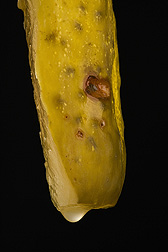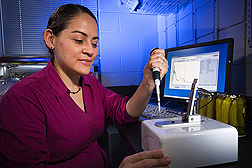Pickle Spoilage Culprit
May Give the Environment a Helping Hand
|
|
If the next jar of pickles you reach for looks a little red—stop! From time to time pickled cucumber products can get a red coloration indicative of benign spoilage bacteria. Though this doesn’t happen often, it can still be an unpleasant experience. ARS scientists in the Food Science Research Unit (FSRU) in Raleigh, North Carolina, have found its cause, how to prevent it, and more.
According to ARS microbiologist Ilenys Pérez-Díaz and her colleagues, some species of Lactobacilli—food-related microorganisms—can cause the red coloring when combined with tartrazine, which is a yellow food-coloring agent.
But Lactobacilli can be beneficial, too. During testing, the FSRU team noted that several Lactobacilli also modify azo dyes—dyes used in the textile industry that may be passed along to wastewater streams if untreated. This is the first report that food-related microorganisms can transform azo dyes.
Azo dyes impart vivid and warm colors such as red, orange, and yellow to fabric. Though many azo dyes are nontoxic, some have been found to be mutagenic. “Considerable effort has been made to identify microorganisms capable of degrading azo dyes in wastewater streams from the textile industry,” says Pérez-Díaz. “If food-grade Lactobacilli capable of degrading a range of azo dyes were identified, they might be organisms of choice for waste-treatment applications.”
This revelation spawned from research that began long ago.
|
|
Thirty years ago, ARS scientists fingered Lactobacillus casei as the cause of the red spoilage. Another outbreak some years later prompted further research, which identified another bacterium in the Lactobacillus genus —L. paracasei—as the culprit when FD&C yellow no. 5 (tartrazine) was added to the brine solution. Commercial dill pickle makers use either this dye or turmeric to impart a yellowish tint to the pickles’ brine.
Pérez-Díaz and her colleagues isolated Lactobacilli from spoiled jars of hamburger dill pickles and used those isolates to inoculate nonspoiled jars of hamburger dill pickles. “Jars that contained brines with tartrazine developed the red hue on the pickle skins; those that had turmeric or no added coloring did not,” she says. “We also found that pH level played a role in the development of red discoloration on pickle skin. A pH between 3.9 and 3.5 supported bacterial growth, disappearance of tartrazine, formation of red-colored spoilage, and a drop in pH.”
Seven treatments were tested in an attempt to find a preventive measure for red-colored spoilage. Pérez-Díaz found that adding sodium benzoate prevented bacterial growth, disappearance of tartrazine, and development of red spoilage. According to Pérez-Díaz, this would be a practical method to prevent development of red-colored spoilage in hamburger dill pickles.—By Sharon Durham, Agricultural Research Service Information Staff.
This research is part of Quality and Utilization of Agricultural Products, an ARS national program (#306) described at www.nps.ars.usda.gov.
Ilenys Pérez-Díaz is in the USDA-ARS Food Science Research Unit, 322 Schaub Hall, Box 7624, North Carolina State University, Raleigh, NC 27695-7624; (919) 513-0165.
"Pickle Spoilage Culprit May Give the Environment a Helping Hand" was published in the September 2010 issue of Agricultural Research magazine.








